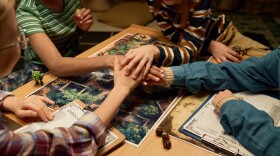Unexpected partnerships are helping the 40-year-old Schlitz Audubon Nature Center manage its 185 acres along Lake Michigan’s shore in Bayside, Wisconsin.
Cardinal Stritch Digs Into Schlitz's Human History
David Pacifico coordinates research and policy in Cardinal Stritch University's School of Continuing and On-line Learning. He also holds a PhD in Anthropology.
Digging into how people from long ago lived their lives is Pacifico's passion.

And, that passion resulted in him wanting to figure out what people left behind on the landscape that is now the nature center.
Pacifico is delving back to pre-1885. According to the Milwaukee County Historical Society: "In 1885, the site was acquired by three brothers of the Uihlein family, owners of the Schlitz Brewing Company. In 1887, they deeded the property to the brewery." After long hours of delivering heavy beer kegs by carriage, the brewery's horses used to recuperate there.
Even before he moved from Chicago to Milwaukee, Pacifico and his family had visited Schlitz Audubon and questions started percolating, like What about Dutch and German immigrants who farmed here before the Uihleins and Schlitz came on the scene?
Pacifico is not the first to contemplate early life here. A 1972 Milwaukee County Historical Society publication reads:
The Garrett Walters’ farm of 30 acres was along the lakeshore east of the Schmalz farm….Walters bought this farm on December 20, 1848 and Mr. Walters had the contract to build the first Fox Point public school on Fox Lane in the southwest corner of what is now Doctors Park.
On a sunny March day, he lead a group of more than 50 people on a walk along the Schlitz Audubon terrace, hoping to find traces left behind from the people who used and built on the land long ago. Pacifico was especially hoping to discover footings of a barn built by another family – the Swart’s.

In no time, someone from his makeshift archeological crew spotted the foundation. Pacifico was euphoric and immediately pondered how many cows resided in the barn and whether their owners left relics of their lives behind.
Marc White, Schlitz Audubon’s director of Conservation, is delighted with the Cardinal Stritch archeological partnership and says it’s bringing new people to the nature center.
Pacifico is also hoping others will catch the bug and go looking for histories like these. He even created an interactive portal – called the Milwaukee Community Archaeology Project - that allows amateur archaeologists to add and compare their findings. Anyone can join in the project – but it is set up like an online course, so people need to sign on by getting in touch with Pacifico.
Wisconsin Arborists Association Helps Schiltz Audubon Tend To Beetle-Infested Trees

Another partnership Schlitz Audubon has been fostering is with the Wisconsin Arborists Association.
Schlitz Audubon recently learned it has been hit by emerald ash borer. The invasive beetle stands to decimate 35 percent of the nature preserve’s canopy.

The center's Marc White says his small team has been able to tend to some of the center’s most potentially hazardous areas, including where little kids enrolled in the center's preschool spend time. The goal is to take out the dying trees before they become a safety hazard, but he says, they are having trouble keeping up.
“We’ve had two mild winters in a row and [the beetled] are just eating all the time,” White explains.
With the help of the arborists association, twenty fully-equipped, volunteer arborists came to help for a day in late March. They set out to remove as many ash trees as they could.
One volunteer team took on the tricky task of tending to trees on the steep bluff that leads to Lake Michigan. The slope is already prone to erosion.

In another spot, a vulnerable old ash with wide reaching branches is not only inconveniently positioned with a building just to its north, but a sugar maple is growing right up through the tree. "So with the loss of the ash, we have the maple and that black cherry over there are going to start taking over that spot, but only if we can take the tree down without crushing or damaging them,” White explains.
Schlitz Audubon hopes to treat some of its still unaffected ash trees – especially those sprinkled throughout the delicate bluff area."But," he says, "we haven’t been able to find funding for it."
Last spring another wrinkle appeared, in the form of an endangered bumble bee. “We found rusty-patched bumblebee on-site, which is a federally endangered bee," White shares.
While this was a wonderful discovery, it means the center cannot use many of the insecticides typically used to fight off the emerald ash borer. "All we could possibly use is triage,” he adds.
Though much work remains, over the course of the day in March Wisconsin Arborists Association volunteers were able to tend to nearly 80 ash trees, including a bunch along Schlitz Audubon’s popular hiking trails.

Have an environmental question you'd like WUWM's Susan Bence to investigate? Submit below.
_






